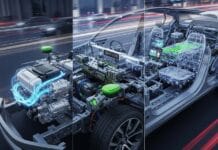Web design continuously keeps changing with the changes in technology and the needs of users. In 2025, websites are more than just information hubs; they are immersive experiences, dynamic interfaces, and personalized interactions. Being in touch with the current trends is not just on the superficial level, but rather on the level of designing effective, engaging, and future-proof digital platforms that will captivate anyone who views it.
Whether it be ultra-modern aesthetic, or the improvement in core accessibility and performance, being aware of such trends will be an instruction that will allow both designers and companies to develop influential online presence that current users will be able to connect with.
What are web design trends?
Web design trends are emerging patterns and styles in how websites are visually structured, functionally developed, and interact with users. New technologies, shifts in the behavior of users, distinct aesthetic tastes, and the need to have personalized digital experiences are the main factors shaping these trends. They often reflect broader shifts in technology and culture, dictating what users expect from a modern website.
On the other hand, following modern tendencies is the sign of a progressive company, and can dramatically increase interaction experience, resulting in longer length of visits, increased satisfaction, and finally increased business performance. Being updated is what helps in having a competitive advantage in the crowded digital realm.
List of Top 10 Best Web Design Trends for 2025:
1. Interactive 3D Elements: Immersive User Experiences
Web interfaces use interactive 3D elements to make them more realistic. They eliminate dull pages and make them interactive. The users have the option of spinning the products, navigating virtual rooms, or navigating data visualizations. This makes a personalized appealing and Living-Browse experience.
The use of a 3D component makes it considerably appealing. It enhances user interaction with a more sense of touch. This trend goes past flat designs. It provides a spatial, vivid knowledge of a content. It impresses those who are visiting it at the moment.
For example: An e-commerce site selling custom furniture uses interactive 3D models. A spin chair with a chair allows a visitor to look at it in all perspectives. They are able to transform fabrics textures in real-time. This gives a good preview prior to purchase which increases the confidence of the buyer. A lot of components have become compatible with 3D transforms in Elementor. This makes it easier to implement web design trends with Elementor.
2. Micro-Interactions: Subtle Enhancements for Engagement
Minor, discrete animations or visual effects can be called micro-interactions. They give instant response to user activities. Consider a simply colored button that is being gently changed by the color on hover. Or an icon of a pair of hands that go on when clicked on. These small elements make a site seem responsive.
Such interactions improve the user experience, since they make it easier to use. They facilitate users in smooth processes. Micro-interactions add personality to a website. They make a pleasant and memorable impression. This makes dealing natural.
For example: A user submits a form on a website. As opposed to generic “Thank You” notification, the submit button is temporarily replaced with a check mark. This little animation certifies the success of submitting an assignment. It guarantees the user.
3. AI-Generated Content and Design Assistance: Efficiency and Personalization
AI is revolutionizing web design by automating content creation. It is also relevant in designing. AI tools may write, draw, and even design full layout proposals. This will streamline the design process largely. AI makes it possible to hyper-personalize.
AI-powered features allow websites to adapt to individual user preferences. Better than Canva site builder, AI streamlines repetitive tasks. Designers focus on strategic decisions.
This provides very applicable contents and designs. The designers are able to concentrate on strategic judgment. Artificial intelligence does monotonous jobs. This increases the level of productivity and creativity.
For example: An e-commerce website uses AI to generate product descriptions. It recommends products also and it is personalized. The AI compares the Browse history of the users. This makes buying customized. Elementor’s AI features are making it easy to implement web design trends with Elementor.
4. Organic Shapes and Fluid Layouts: Natural and Inviting Aesthetics
This is a departure with what basically used to be rigid grid designs. It adopts nature, asymmetrical patterns, and free-flowing designs. Soft curves, wavy lines and irregular blobs. These details make a human, open, and vibrant aesthetic.
Softness and fluidity are given by organic shapes. They make a breach in standard geometric layouts. This makes websites feel more approachable and less sterile. It provides special visual appeal, which draws visitors.
For example: A health and wellness website uses overlapping, soft-edged shapes as background elements. These cross barriers. This brings a feeling of peace and ease of flow. It gives a relaxing picture to the visitors.
5. Bold Typography: Making a Statement with Text
Bold fonts employ huge, dramatic, and unique fonts. It turns text into one of the main design elements. The visual fleeting anchors emerge as headlines. This follows the trend to readability and aesthetic impact. The words can be exchanged with emotion using it.
Bold typewriter enables it to develop an authoritative brand voice. It brings order to the page. The most important messages cannot be missed. This enhances readability of contents and user understanding. It enhances a lot of character to a design.
For example: A creative agency’s website uses a massive, custom sans-serif font for its hero section headline. Even the typography speaks of creativity and boldness. It takes the stance of the brand quickly, and it attracts the attention of a visitor.
6. Glassmorphism and Neumorphism: Modern Visual Textures
Glassmorphism will give a blurred and frosted background glass appearance. It tends to have near shadows and edges of light. Neumorphism uses extruded soft shapes that thrust out of the background. Both offer physical and multi-dimensional dimensions.
The trends are modern and stylish. Glassmorphism provides the impression of light-weightedness and transparency. Neumorphism makes elements appear physical and soft. They increase visual appeal and conceived quality.
For example: A tech company’s website uses glassmorphism for its navigation menu. The blurred background gives way to what it is hidden behind. This has the effect of producing a smooth, futuristic and layered look that increases user interaction.
7. Dark Mode & Eye Comfort: User-Centric Display Options
Dark mode provides a darker color scheme for websites. This decreases eye-strain in low-light settings. It preserves battery in OLED screens. The ability to give a toggle light/dark mode enhances user control.
The introduction of the dark mode is a sign of user convenience. It fulfills an increased interest in dark interfaces. This makes it easier to understand and gives a personal Browse. It benefits in keeping users on longer sessions.
For example: A news website provides a dark mode toggle in its header. Users can switch to a darker interface for reading articles at night. This helps to cut down on glare and makes for easier reading, and is more comfortable.
8. Minimalism with Bold Accents: Striking Simplicity
This is a trend that merges the minimalism with the minimal lines and excess whitespace. It assimilates effective, dynamically colored flashes or powerful imagery. It continues to be content focused. The visual impact of text and pictures in this work is due to bold items.
Minimalism guarantees no clutters and easy user experience. The design is not dull because of bold accents. This forms a high brow and compelling style. It points at important details.
For example: A portfolio website uses a clean, white background with minimal text. Nevertheless, call-to-action buttons use bright neon. This contrast makes the buttons stand out at once. It brings in personality as well.
9. Retro and Nostalgic aesthetics: A blast of the past
Retro web design borrows signs of the former times. This involves pixel art, old-style typography and neon colors. The nostalgic objects hint at a natural sense of familiarity and homey feeling. These help in making a brand easily recognizable.
This is a trend that enables brands to rise above the rest. It brings forth the nostalgia in the users. It gives something unusual, funny or artful. There can be the creation of a very strong emotional connection with retro elements. This promotes recollection.
For example: A gaming website uses pixelated graphics for its icons. Its font resembles the 8-bit fonts. This generates a great feeling of the retro arcade. It appeals to players who are born into the era of the golden age of video games.
10. Voice User Interface (VUI) Optimization: Hands-Free Interaction
Voice User Interface (VUI) optimization prepares websites for voice search and interaction. It means organizing verbal queries in content. It also involves incorporation of voice command to guide navigation. The trend is equal to the growth of intelligent speakers.
Optimization of VUI enhances the accessibility of disabled people. It provides a Browse that is hands-free. This increases ease of use to mobile users. It future-proofs websites for evolving interaction methods. This makes the site more generic.
For example: A recipe website optimizes its content for voice search. The user may request his or her smart speaker, “How do I have chocolate chip cookies?” The website provides concise, verbally friendly instructions. This provides hassle-free cooking.
Conclusion
To develop striking and effective online presence, it is important to be up to date with the best web design trends anticipated in 2025. Ranging in such possibilities as immersive 3D design to micro-interactions and the increasing use of AI, all these trends highlight the movement towards more interactive, personalized and people-oriented web experiences. Staying current with these innovations ensures your website not only looks modern but also performs optimally and engages visitors meaningfully.
The implementation of these trends will result in enhanced user-satisfaction and brand identification as well as the long-term success in the ever-changing realm of the digital medium.





